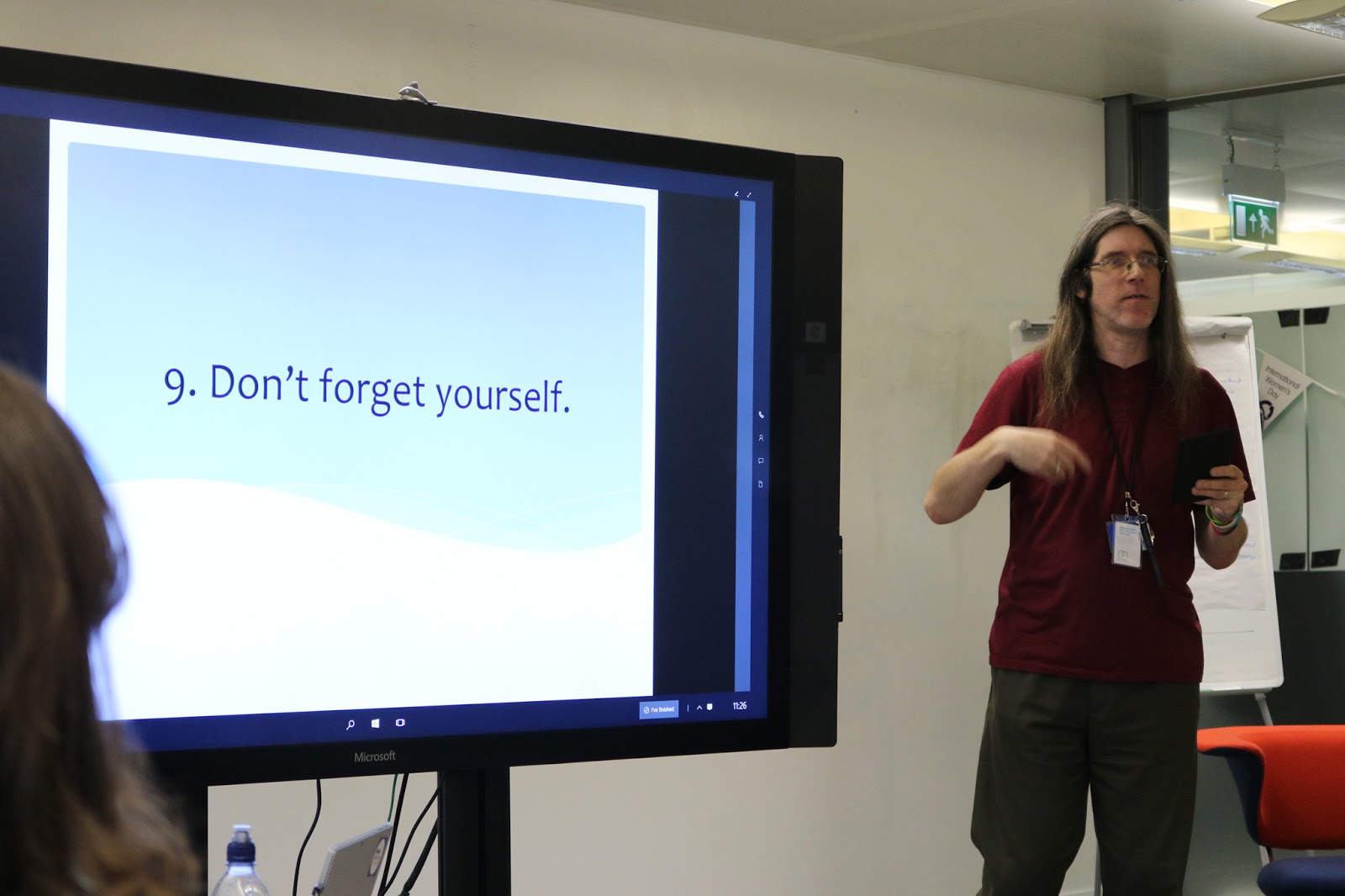My pronouns are he/him/his.
Observed each year on November 19, International Men’s Day (IMD) celebrates the positive value men bring to the world, their families and communities, highlighting positive role models and raising awareness of men’s well-being, including mental health. I shared some general thoughts on connection and conversation for IMD last year. This time, I thought I’d go a little deeper, and explore what being a man means to me.
That should be pretty easy, right? I’ve had sixty-one years to figure out what being a guy is all about. Oddly enough, it’s proven a lot harder than I imagined. It’s not that I’ve ever felt misgendered, or unhappy at being thought of as male. I’ve worn my gender identity all my life, albeit without thinking much about it. I was a boy. I am a man. But what does that mean?
Let’s start with International Men’s Day itself. Do I feel it’s for and about me? Does it resonate? It does, yes. Last year was the first time I’d engaged with IMD, building on work I’d done earlier in the year exploring aspects of my mental health in articles such as Return to Down and This Boy Gets Sad Too, and men’s mental health in general. I attended a series of sessions at work organised for IMD last November, one of which focused on men’s physical health. It prompted me to face concerns I’d had for some time, and arrange my first GP appointment in thirty years. I’m glad to say the tests, for prostate cancer, came back negative, but it brought home to me the realities of living with this biologically male body.
For me, though, being a man isn’t just a matter of biology. Trans women and non-binary people who were assigned male at birth are also at risk of prostate cancer and other “men’s health” concerns. Conversely, a trans man might have physical health issues that I never will. Maleness has nothing to do with sexual or romantic preference, either. I’ve only ever been attracted to women, but I’d be no less — and no more — a man if I was gay, bisexual, or asexual.
My gender says nothing about me as a person. I’m no better or worse, more or less worthy, as a male than if I was female, nonbinary, or agender. That said, I’d be naive to imagine my gender hasn’t influenced my route through life or how I’ve been treated. I’ve never experienced discrimination because of my gender, been held back, or otherwise treated poorly. The fact I spent most of my adult life ignorant about male privilege speaks volumes. It was easier to be ignorant because it had never affected me personally.
I mentioned romantic and sexual relationships, but what about friends? A recent newspaper article asserts that men have few meaningful friendships, quoting counsellor and psychotherapist Adrian Wilson-Smith:
There are a lot of men having functional relationships with other men – I know this guy because he can help me out with my business idea. Or partying – these are the guys that I go out with for a drink or a line of coke. But enduring friendships, of the kind seen in many female-to-female friendships, are not something that most men over forty see any need to have.
I have good functional relationships with men in the workplace, but I’ve never had party buddies of the kind Wilson-Smith describes. I definitely still have a need for caring and mutually supportive friendships, but those I have are almost all with women. Indeed, I’ve had very few male friends since I was at university. I can no longer claim to be a young man but I’m reminded of a quotation by Leo Tolstoy: “Nothing is so necessary for a young man as the company of intelligent women.” I’ve no idea how common it is nowadays for men to have meaningful friendships with women, but the newpaper article only mentions same gender friendships: men with men or women with women.
International Men’s Day is founded on six key pillars “which are applied equally to men and boys irrespective of their age, ability, social background, ethnicity, sexuality, gender identity, religious belief and relationship status.” If manhood can encompass all those differences, there must be something that men have in common. But what? This question is important to me because despite being a man, I feel little sense of commonality with most other men, or with men in general. This isn’t new. As I wrote in Belonging (Longing to Be) I’ve never truly felt part of things.
More often than not I’ve been an outsider looking in through the window. [...] Our gender group is arguably the most fundamental belonging, but it’s eluded me. I’ve had very few adult male friends, and little of “what men are supposed to like” resonates for me.
I watch TV adverts for “men stuff” — razors, body spray, shampoo — with amusement because I relate to very little of it. (I prefer Head and Shoulders Supreme Moisture or Smooth and Silky shampoos to the Men Ultra or Classic Clean varieties. This may or may not have anything to do with me fancying Claudia Winkleman, who fronts the H&S adverts.) I’ve never felt at home in what are traditionally seen as men’s spaces or activities such as football (playing or watching), men’s clubs, or communities centred on formerly male-dominated industries such as mining or shipbuilding. Even ordering at the bar was a man skill that eluded me until quite recently. This is important because initiatives to help and support men tend, understandably, to focus on the places men go and the things men do. Except, I don’t go to those places, and I don’t do those things.
I’ve written before of peer-led groups such as Andy’s Man Club, which runs “talking groups throughout the UK for men who have either been through a storm, are currently going through a storm or have a storm brewing in life.” In similar vein, Men’s Sheds organises “community spaces for men to connect, converse and create.[...] They help reduce loneliness and isolation, but most importantly, they’re fun.” I recognise the value of such groups. I’ve even thought of seeking out a group near me. I’m nevertheless put off by the very thing that’s meant to attract me: their male-centredness. I might surprise myself if I gave it a go, but I imagine I’d struggle to relate to other members on a man-to-man basis.
All that said, I do feel I’m making progress. I identify strongly and instinctively with the message and marketing of Boys Get Sad Too, a fashion brand working for positive change. I wear my BGST hoodie with pride. It’s one aspect of “being a man” which, for some reason, I feel able to embrace wholeheartedly. That brings up the question of dress and appearance. How much does how I dress and present myself align with and express my sense of being a man? My beard is a bit of a giveaway, but then again, that’s biology not gender. In the past I’ve grown it in full Gandalf style. These days I keep it trimmed close. That may be vanity. I feel better and imagine myself looking better this way. I wear my (Smooth and Silky™) hair as long as it will grow. Long hair is important to how I see myself and I can’t imagine cutting it voluntarily. Does it make me look less, or more, “manly”? I don’t know and don’t really care. I tell myself that CSNY would approve.
I don’t believe clothes, colours, and styles are inherrently gendered, but I dress in a manner unlikely to leave anyone guessing. Most of the time I wear t-shirts and cargo pants, which are pretty much unisex, but my coats and jackets are more conventionally male. My favourite item of clothing is the Scottish tweed jacket I picked up second hand a few years ago. I’d be hard pressed to explain why but, as with my BGST hoodie, I feel good about myself the moment I put it on.
I’ve never had heroes or role models, but I’ve been thinking about some of the key men there have been in my life. I knew neither of my grandfathers, but my father and two uncles exemplified different aspects of maleness as I was growing up. I’ve written about my father before; briefly in a passage excerpted from our book High Tide Low Tide, and at greater length in an open letter. The latter, written decades after his death, captures the essence of our relationship. He was the head of the household. He was never overly strict or authoritarian, but he wasn’t open with his feelings. I loved and respected him, but I never knew him. As I wrote, “I have no idea how you felt about your life. Or your death.”
My father was distribution manager at Distillers Company Ltd. In Liverpool. I remember him taking me into his office one Saturday. I was perhaps nine or ten years old. I was fascinated by the high desks with their rows of typewriters but I never wanted to follow his choice of career. His love of Western movies was a different matter. I desperately wanted to be a cowboy; or failing that, to drive a steam locomotive like Alan Hale’s character Casey Jones in the television series of that name. Needless to say, my dreams of being a cowboy or a locomotive engineer went unfulfilled.
My father’s brother John — Uncle Jack — was an architect and pipe smoker. Those are the first things that come to mind when I think about him. Pipe smoking might be considered a quintessentially male activity, but the only other pipe smoker I’ve known was a woman I worked with in London after graduating from university. I’ve never smoked a pipe, cigarettes, or anything else, but Uncle Jack’s pipe and the paraphernalia that went with it fascinated me. He gave me a smoker’s companion: a three piece tool that slid inside a narrow metal case. I loved technical drawing at school and harboured ideas of becoming an architect like Uncle Jack until I switched allegiance to follow the biological sciences. He gifted me one of his draftsman’s mechanical pencils, a Rotring technical drawing pen, and a fully-rigged model of the Mayflower. I wasn’t his only nephew but he and my Auntie Elsie had no children of their own; a rarity in my extended family. It’s possible he saw me as a child after his own heart.
My mother had four sisters and two brothers, all but one of whom lived locally. Uncle Charlie was married to my mother’s sister Clarice (Cal). I enjoyed visiting their narrow terraced house with its sliding door leading to the staircase, its paved back yard, and the rail line running no more than twenty feet from their back gate. Most of all, I loved Uncle Charlie’s shed. He was a joiner by trade, and his shed was an Alladin’s Cave of tools, wood shavings, sawdust, half-finished projects, and glass jars holding an assortment of nails, screws, paint brushes, and other treasures. He was the archetypal artisan and craftsman who earned his living with his hands but also put his skills to use for the pleasure of himself and his family. He had a wonderful sense of humour, a permanent twinkle in his eye, and I think of him now with great fondness.
Another man who influenced me was the second husband of one of my cousins. I didn’t know him well but I remember how devoted and caring he was to my cousin and her daughters from her first marriage. That devotion served as a template or model of a caring husband and father when, many years later, I became first a step-father and then a father. I make the distinction deliberately. I’ve never understood how anyone can view their step, foster, or adopted children as any less than or different from their biological offspring. I can express it no better than this answer posted on Quora in response to the question Do you think you could ever love your step-child as much as you love your actual child?
My stepdaughter IS my actual child.
So is my adopted son.
So is my biological son.
I’m their Dad and earned that title by reading to them, feeding them, helping them with schoolwork, playing with them, listening to their troubles, caring for them when they were sick, transporting them hither and yon, and taking daily delight in having them in my life.
The notion that any of my flavors of parentage aren’t “actual” is absurd.
— Andrew Weill
I’ve written elsewhere about four men I respect, including my son Mike. Two of the people I most admire in the mental health community are men.
In the realm of fiction, Samwise (Sam) Gamgee from J. R. R. Tolkien’s epic fantasy novel The Lord of the Rings exemplifies aspects of the steadfast and caring friend for me. Played by Douglas Henshall, Detective Inspector Jimmy Perez in the British television crime drama Shetland is one of very few male roles I’ve ever identified with or wanted to emulate. I wrote about him in an article titled Being Jimmy Perez: Shetland and the Art of Listening.
What struck me is how good Perez is with people going through crisis and change. (He is less good with his own crises and changes, but isn’t that the way of things? The series closes with a hint he may finally be finding a way forward.) Whether interviewing a suspect, talking with witnesses, confronting a violent crime boss, or engaging with colleagues, his stepdaughter, or a new lover, Jimmy Perez is usually calm and measured, although he can be assertive when necessary. He doesn’t always get it right but he owns his mistakes. He comes across as honest, genuine, and caring. He is someone you’d feel safe with.
Those final sentences express how I hope I’m perceived, as a person and as a man. Honest, genuine, and caring. Someone you feel safe with, emotionally as well as physically. These qualities are not the prerogative of men, of course. Maybe I’ve been asking the wrong question all along. What’s most important about Jimmy Perez, Sam Gamgee, my father, my uncles, or my cousin is surely not their maleness, but their character. I couldn’t care less whether they are sufficiently “manly.” What matters is their — and my — integrity, compassion, and goodness. No matter our gender, isn’t that what’s most precious and important about each of us?
Over to You
While writing this piece, I asked a number of people what their gender means to them. None found it easy to answer. I posed the question on social media, and received the following responses.
[To me it means] living life through understanding. (Paul)
I’ve said to many men over the years ... “Want to be a better man? Start thinking like a woman.” I do that! Mental alertness and intuition are the defining experiences of this time we live in and women are stronger in those than men! (Paul)
I’ve never given it much thought except when gender prevents a lack of opportunity for equality. I think the glass ceiling has lowered a bit but has to descend further. I’m thrilled to be part of the gender able to experience the miracle of giving birth ... then get those men back beside me to continue the journey. (Maureen)
It’s strange. Tonight, as I was out to dinner, I felt inadequate. I don’t wear make up or cutesy boots with tops and scarves. I don’t attract boys because I’m a tomboy, I think. I’m not very girly at all. I don’t wear heels or dresses unless I’m going to a funeral or a wedding. So, I’m a feminine? I don’t know exactly. From a male’s perspective, probably not. Then again — like you, Marty — I have never been group-oriented. I walk my own way. I have tremendous intuition, which feels like a great gift and at other times, a curse. I identify as a girl but I’m not typical at all. I’m fussy about my hair! I don’t paint my nails. You get the idea. In recent years, I’ve learnt a little bit about the divine feminine ... the female aspect of God. It seems fitting that there is a female counterpart to a very male God. I feel we need a balance, because we all matter and I think at our best, males, females or whomever, are sacred regardless of gender. (Brynn)
What does your gender mean to you? Do you have role models? Who are they and what do they represent to you? I’d love to hear your thoughts and ideas, either in the comments below or via our contact page.
Photo by Andrew Neel at Unsplash.














